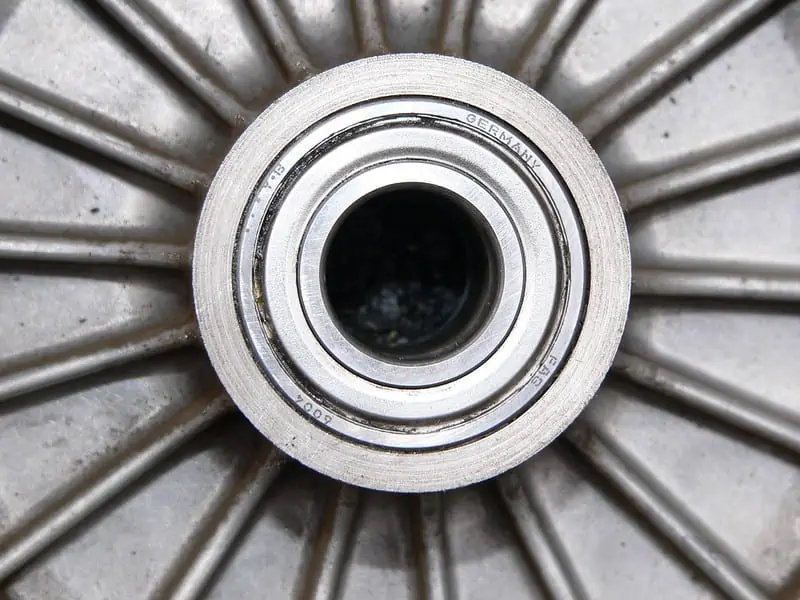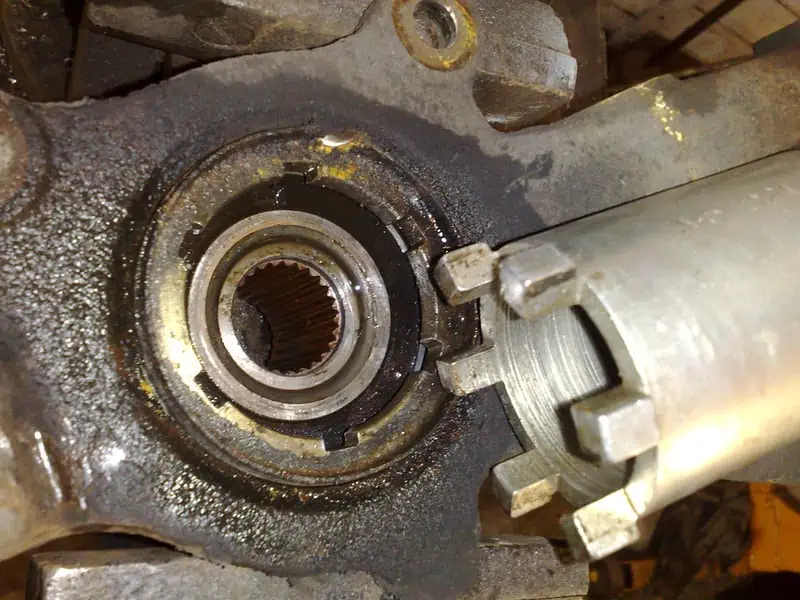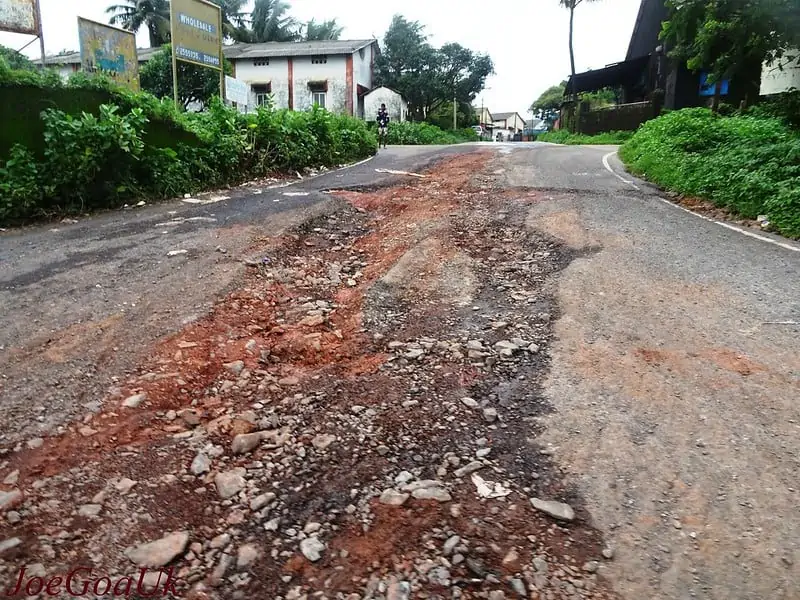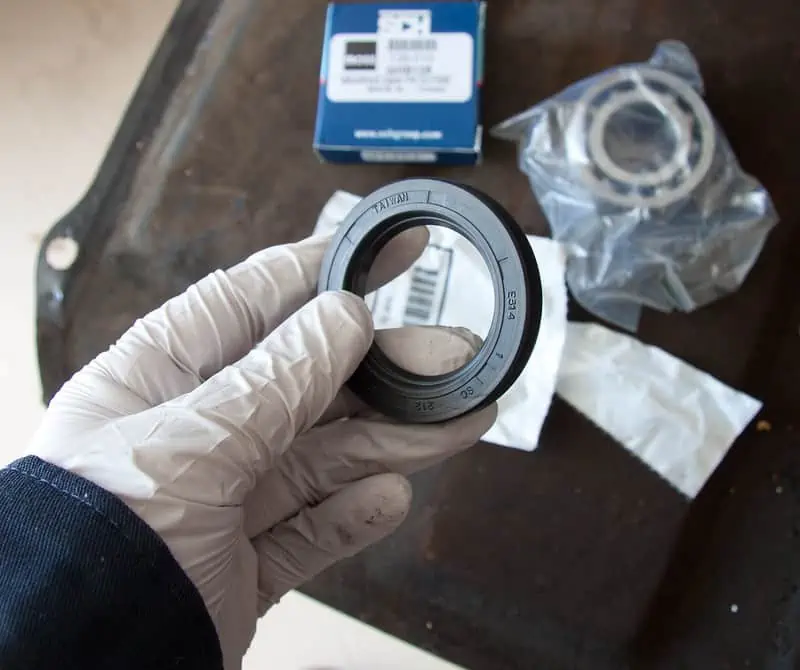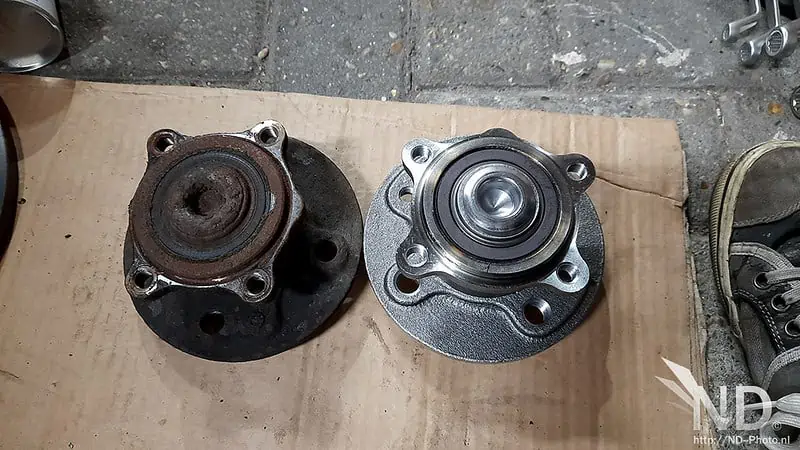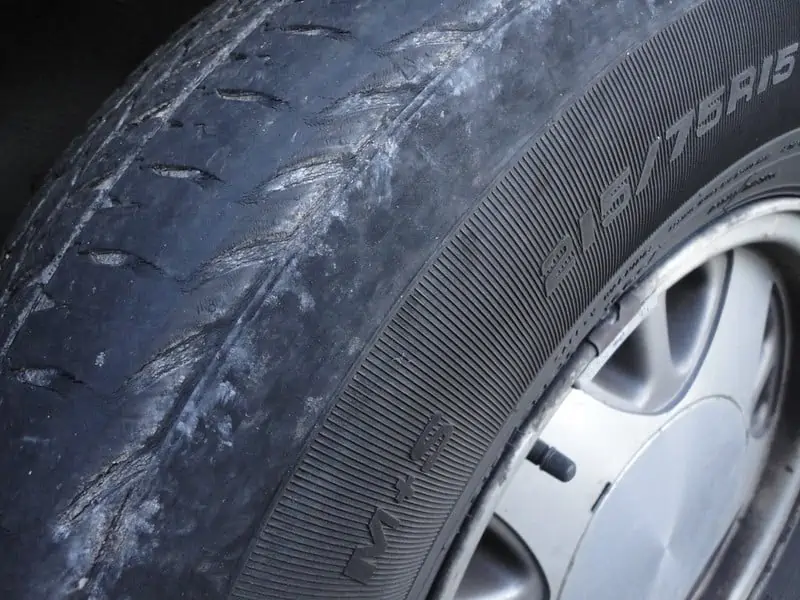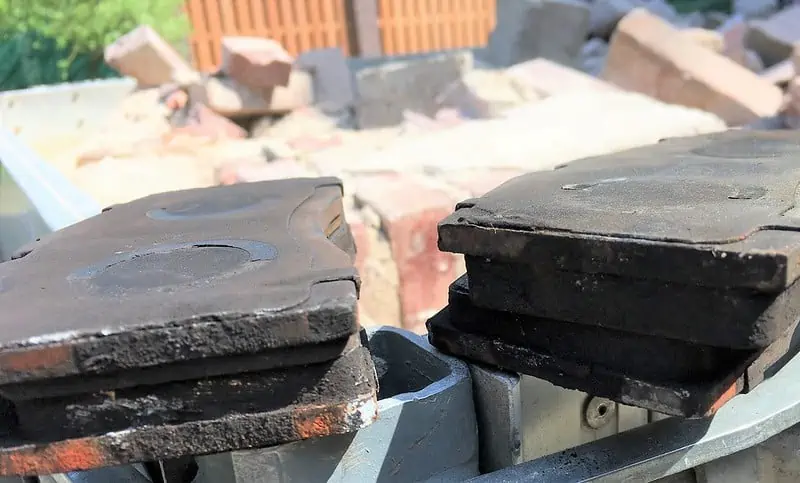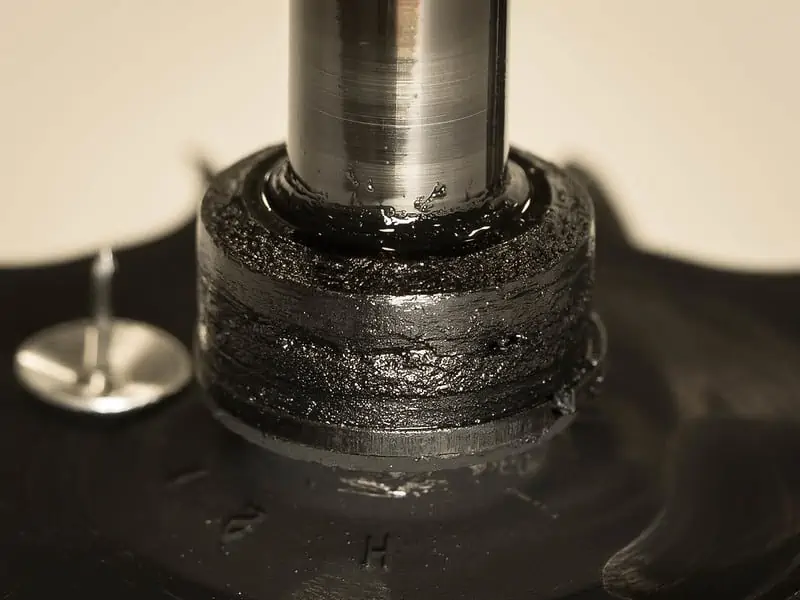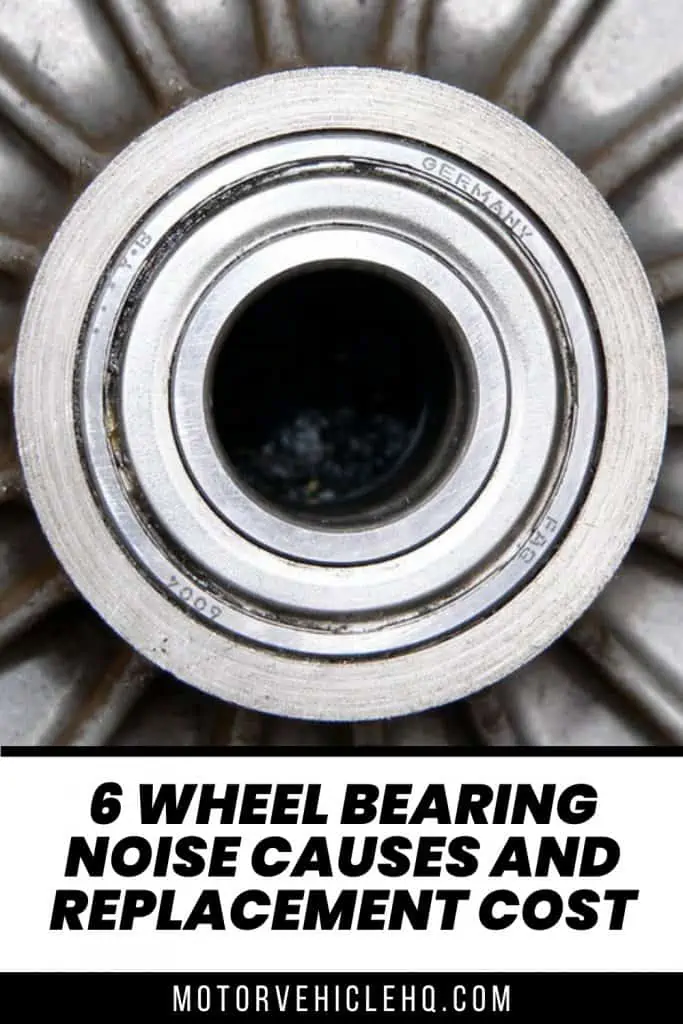Wheel bearings are safety components whose task is to provide smooth and consistent movement of a wheel. They are designed to reduce rolling friction and give your car wheels the freedom to spin while maintaining the weight of your car. But then, even these safety components can become defunct over time. They can suddenly become noisy; producing clicking or grinding noises. When this happens, driving becomes an uncomfortable experience. In extreme cases, it could result in accidents. See? They cannot be left out when conversing about the primary parts of a car. Because of this, wheel bearing malfunctions need to be addressed as soon as possible to prevent more damage.
In this article, we will explore five common causes of these noises and ways to prevent them.
What are wheel bearings?
Front wheel bearing by Aminorjourney / CC BY-NC-ND 2.0
Wheel bearings are round, metallic parts located in a wheel hub that is responsible for connecting your wheel to your car. This wheel hub connects to your car’s wheel axle, located on the brake disc side of the chassis. They are held in place by a circlip or spring. When the wheel is turned, the rotational force causes the bearings to spin around their vertical axis, creating friction. This friction then causes tiny metal particles to be scraped from the bearing surface. With time, these tiny bits of metal can build up and become detached, resulting in a loud screeching sound when the wheel is turning and causing the seals to wear out faster.
Wheel bearings are important in making your car function optimally.
Common causes of wheel bearing noises
The most common causes of wheel bearing noises include:
Excessive wear and tear
The most common cause of wheel bearing noise is excessive wear and tear. This can be caused by several factors, including using a wheel bearing of poor quality, driving with worn tires, hitting curbs with the wheels, and inadequate lubrication of the wheel bearings. Driving on wet or icy roads can also cause damage by causing excess friction. If this happens to your wheel bearings, you may notice the noise coming from the front left side of your vehicle. This is due to the alignment being off — one of the front wheels must work harder than the other(s) to compensate for the misalignment.
To prevent excessive wear and tear on your wheel bearings, maintain proper tire pressure, avoid driving on wet or icy roads, and use appropriate lubrication. If you do experience excessive wear and tear, be sure to have your bearings replaced as soon as possible.
Improper Installation
One of the causes of wheel bearing failure is improper installation. This can be caused if the mechanic is ignorant or chooses to neglect your car manufacturer’s guidelines. They can also happen by using unorthodox tools such as a hammer or an impact wrench which can result in both interior and exterior damages, making your wheel bearing fail earlier than it should.
Front wheel bearing ring removal tool by Tony Harrison / CC BY-SA 2.0
Reusing old attachments such as bolts, nuts, seals, and so on instead of disposing of them and getting new ones will make your wheel bearing function in an unfriendly environment, making it fail faster than it should have.
Unbalanced Tires
When your car tires are not of the same size, the weight of your car will be more on one side than on the other, meaning that you’ll be putting uneven strain on some tires, causing those wheel bearings to work harder than expected, hence resulting in noise.
Corrosion on the wheel bearings
Another common cause of wheel bearing noise is corrosion. This can occur when rust forms on the outer surface of the bearings due to moisture entering the bearing seals or grease caps. This corrosion can cause the bearings to lose their lubrication, which in turn results in noise. Other common causes of corrosion include contact with road salt or other chemicals, contact with brake dust, and exposure to high temperatures.
To prevent corrosion from damaging your wheel bearings, make sure to keep the vehicle dry and clean all of the dirt from the wheel seals and caps regularly. You should also consider using an anti-corrosion spray for the wheel bearings every few thousand miles.
Bad Roads
If you constantly drive on bumpy roads, roads with potholes, salty roads, or dirt roads, your wheel bearings will be negatively affected.
Roads like this strain your bearing by Joegoauk Goa / CC BY-SA 2.0
Since your wheel bearings carry the weight of your car, you put extra strain on them when you drive on a road with uneven topography. This added strain reduces its lifespan. If you continue driving on bad roads, your wheel bearings will wear out faster.
Driving Through Water
While your bearing seal is there to work against the accumulation of debris and water, it cannot withstand large quantities of both (debris and water).
Wheel bearing seal by Abraxas3d / CC BY-NC 2.0
Over time, this accumulation can cause your wheel bearings to become noisy.
Driving in deep water either as a result of a flood or other causes will allow water to escape into your wheel bearings. This water will contaminate your wheel bearings leading to their failure. These specks of dirt work against your lubrication oil by increasing the level of friction. If you drive through water frequently, you should have your wheel bearings checked.
How Much Does Replacing a Wheel Bearing Cost?
Wheel bearings fitted in wheel hubs of a mini cooper by ND-Photo.nl / CC BY-NC-ND 2.0
A wheel bearing replacement, including labor, costs between $200 and $1200. This is dependent on whether the complete hub is replaced or simply the wheel bearing, which varies depending on the vehicle type. This is because vehicles either come with a wheel bearing that can be removed from the hub or the wheel bearing is built into the hub.
If the wheel bearing can be separated from the hub, the cost of purchasing only the wheel bearing is substantially lower than purchasing the entire hub.
The disadvantage of replacing only the wheel bearing is that it is more labor-intensive and requires unique tools.
However, you can opt to purchase a new wheel hub as it is significantly less labor-intensive, but purchasing a new hub will cost far more than purchasing a new wheel bearing. A wheel bearing costs between $50 and $120 on average, whereas a new wheel hub costs between $200 and $500.
Signs of a Bad Wheel Bearing
The signs of a defective wheel bearing include:
Strange Noises
When you hear strange noises from your car, there’s the possibility that the wheel bearing of your car has gone bad. These sounds come from the wheel and tire area and get louder as your car increases in pace. The primary noises a bad wheel bearing makes include but are not limited to cyclic chirping, continuous squealing, and growling. Also, if the noise your car makes becomes louder as you accelerate, there’s a high chance that it is a result of a bad wheel bearing. If this noise gets worse at every turn, it also indicates a bad wheel bearing.
Grinding
If your car grinds while you drive or when you change gears, this is a bad sign. Not only is this high-pitched grind unfriendly to the human ear, but it is also a sign of a bad wheel bearing or perhaps, more serious problems.
Steering Vibrations
If your car has a bad wheel bearing, it can result in the vibrations of your steering wheel. The reason why vibrations occur is that your wheel bearings fasten your wheel hub to vehicle suspension and aid the turning of your wheels. When damaged or not lubricated efficiently, your wheel bearing can cause vibrations which make maneuvering your car difficult. Although this rarely happens, If not handled properly, it can lead to severe cases of accidents.
Abnormal and Uneven Tire Wear
Although there are tons of reasons why your tire can wear such as the misalignment of your car as a result of faulty tie rod ends, a bad wheel bearing can also cause this. To test if your tires are wearing at uneven rates, you need to carry out a physical test by examining your tires and comparing the rate of wear.
Worn out front tire by Badheartbull / CC BY-SA 2.0
You should note that this test can only be done if the four tires were installed either at the same time or the difference between the installations is negligible (a few days to a week).
Pulling while Applying Brakes
If you notice that your car leans to one side when you hit the brakes, it is not normal and could be a sign of a bad wheel bearing. Pulling to one side when the brakes are applied can also signify other issues such as a problem with the Braking System or Sticking Caliper. To ascertain which it is, you should seek the attention of a mechanic.
ABS Malfunctioning/Traction Control
Most wheel hubs come with in-built sensors that inform the ABS, traction control, and other systems designed to assist in driving. When something goes wrong with the wheel bearing, these systems malfunction or/and flash warning lights.
Uneven Brake Pad or Rotor Wear
Uneven brake pad wear by Pim GMX / CC BY-NC 2.0
One of the symptoms of a bad wheel bearing is abnormal wear of your brake pad. You should, however, consider the possibility of other causes such as varying brake pad thickness, dirt, rust in the rotors, cold water making contact with the hot rotor, and so on before reaching this conclusion.
Effects of a Bad Wheel Bearing
When faulty wheel bearings are not repaired on time, it could lead to other more complicated problems. These include:
Axle Damage
If you drive your car with bad wheel bearings for a long time, your car’s axles will eventually pay the price. A damaged wheel bearing also stressed the other parts of your vehicle suspension. What this means is that at the end of the day, the damage cost incurred as a result of a bad wheel bearing will exceed the cost of changing your bad wheel bearing. For example, metal shavings from the failed wheel bearing of your car can affect your wheel hub, thereby fastening its depreciation rate. The CV Joint Boots and various seals can also deteriorate.
An increment in the Wheel Heat
Damaged bearing caused by excessive heat by Jeffry N. Curtis / CC BY-NC-ND 2.0
Friction is your wheels’ way of life. A worn-out wheel can restrict free turning movement, which adds unnecessary friction that translates to heat. This makes your wheels very hot to touch. Increased wheel temperature for a prolonged period can also cause your brake system to collapse.
FAQs
How Long Does a Wheel Bearing Last?
The average lifespan of a wheel bearing is exhausted when the wheel bearing covers between 85,000 miles to 100,000 miles. However, the lifespan of a wheel bearing can be affected by the quality of the wheel bearing and the conditions under which it operates.
Can I Replace My Wheel Bearing Myself?
Although it is best to seek the attention of a mechanic with in-depth knowledge and the right tools, you can replace your wheel bearing yourself. Outlined below is a step-by-step DIY guide on how that can be done. You must note, however, that there can be slight modifications, depending on your car brand.
1: Prepare Your Car
Materials needed in replacing your Wheel Bearing include:
- Bearing Grease
- Floor Jack
- Gloves
- Pliers
- Diagonal cutters
- Two-wheel chocks
- Torque wrench
- Screwdriver
- Wire Clothes Hanger
- Safety Jack Stand
- Ratchet (½ inch with 19mm or 21mm socket)
- Socket set (⅜ set 10mm – 19mm)
Step 1: Put the wheel chocks on a flat surface underneath your car, directly in front of the rear tires if you’re replacing the wheel bearings on the driver’s side and vice versa.
Step 2: Loosen the Lug Nuts with your ½-inch ratchet with the correct size socket for your lug nuts. Loosen the lug nuts but do not lift them off entirely as it is not yet safe to do so.
Step 3: Lift the vehicle using the floor jack and a pair of safety jack stands. This allows you to remove the tire easily. You can refer to your owner’s manual to get the exact points the jack should be placed.
Step 4: Remove the lug nuts completely, then the tire.
2: Install new Wheel Bearings
Step 1: Remove the brake caliper and bracket using your ratchet and ⅜ socket set to remove the bolts from the disc brake caliper and bracket. When this is done, you can use a screwdriver to remove the caliper. When removing the caliper, you must be careful not to let it dangle freely as this might damage the flexible brake line.
Step 2: Remove the Outer Wheel Bearing by using your pliers to eliminate the cotton pin and retaining nut. When this is done, you can slide the rotor forward to release the outer wheel bearing.
Step 3: Remove the Rotor and Inner Wheel Bearing by simply pulling the rotor off the spindle with both hands and allowing the inner wheel bearing to get caught on the retaining nut.
Step 4: Rub Bearing Grease into the Casing.
Step 5: Install the new bearing into the rotor and apply grease to the inside bearing cavity.
3: Reassembly
Step 1: Put the brake rotor and caliper back on since the new bearing wheel has been installed. You should do this using the ratchet.
Step 2: Install the tire (s) and tighten the lug nuts with your fingers (which should be in gloves).
Step 3: Use a torque wrench to tighten the lug nuts. Bring your vehicle down after and remove the floor jack from underneath.
Conclusion
If you ever notice a rattling or grinding noise coming from your vehicle’s wheels while driving, you should have the problem diagnosed immediately by a qualified professional to avoid further damage to your vehicle. Wheel bearings can become noisy over time, but many other factors could lead to this as well. For instance, fitting your car with bigger rims, stiffer shock absorbers, and suspension springs cause a higher load on the wheel bearing.
Proper maintenance, such as wiping your wheel bearings with a clean rag on a regular basis, lubricating, and draining off any extra grease, will lessen the probability of premature failure and lengthen the life of your wheel bearings. Also, if you need to replace your rims, shock absorbers, and/or suspension springs, choose the ones recommended by the manufacturer to ensure the longevity of your wheel bearings.
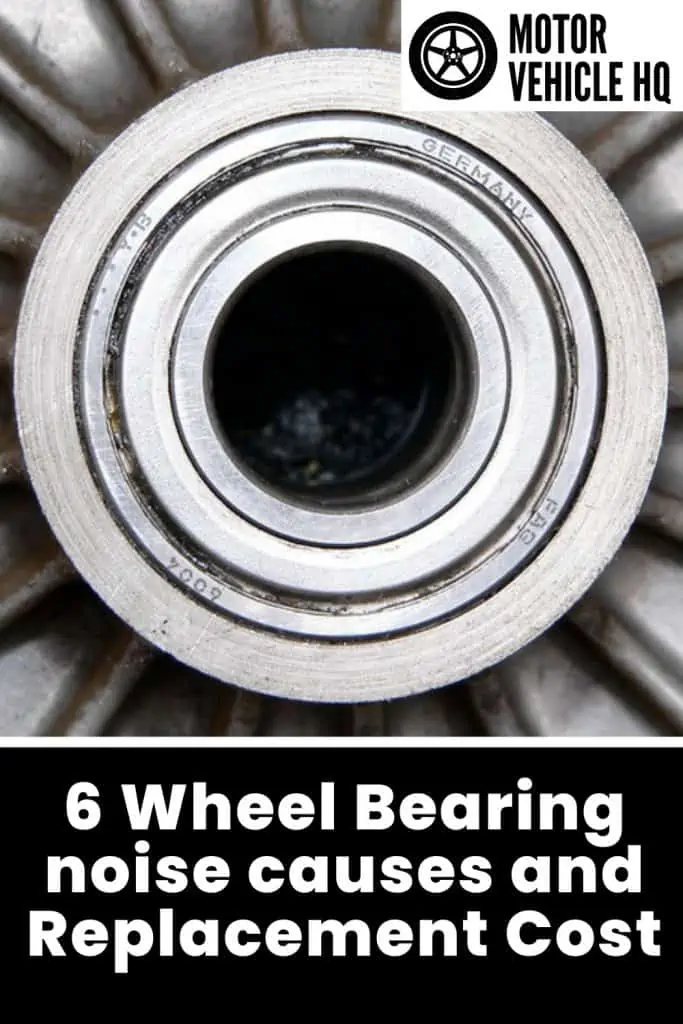

Jim Wicks is the founder of MotorVehicleHQ. With over two decades of experience in the automotive industry and a degree in Automotive Technology, Jim is a certified car expert who has worked in various roles ranging from a mechanic, car dealership manager, to a racing car driver. He has owned more than 20 cars over the past 15 years. Ask him about any vehicle you see on the road and he can tell you the make, model and year. He loves the aesthetics of all things cars, and keeps his vehicles in pristine condition.
In his free time, Jim enjoys getting his hands dirty under the hood of a classic car or taking long drives along the country roads. His favorite car? A 1967 Shelby GT500, a true classic that, according to Jim, “represents the pure essence of American muscle.”
